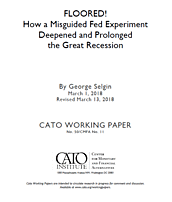The revised book version of Floored!: How a Misguided Fed Experiment Deepened and Prolonged the Great Recession is now available on Amazon.
Floored!
How a Misguided Fed Experiment Deepend and Prolonged the Great Recession
The Fed’s shift to a floor system has had profound and enduring consequences.
Federal Reserve authorities responded to the 2007–8 financial crisis with a sequence of controversial monetary policy experiments aimed at containing the crisis and, later on, at promoting recovery. One of those experiments consisted of the Fed’s decision to start paying interest on depository institutions’ balances with it, including both their legally required balances and any balances they held in excess of legal requirements. Because the interest rate on excess reserves was high relative to short-term market rates, the new policy led to the establishment of a “floor”-type operating system, meaning one in which changes in the rate of interest paid on excess reserves, rather than open-market operations, became the Fed’s chief instrument of monetary control.
Although it has attracted less attention, and generated less controversy, than many of the Fed’s other crisis-related innovations, the Fed’s shift to a floor system has also had more profound and enduring consequences than many of them. And despite Fed officials’ intentions, those consequences, including a radical change in the Fed’s methods of monetary control, have mostly been regrettable. While Fed officials hoped that the new floor system would assist them in regulating the flow of private credit in the face of extremely low and falling interest rates, a close look at the workings of the system, and at its record, shows that those hopes have been disappointed.
As the following pages will show, among its other consequences the Fed’s new operating system
- intensified an already severe economic downturn by serving as the means by which the Fed maintained an excessively tight monetary policy;
- led to a sustained collapse in the interbank market for federal funds, thereby destroying the Fed’s traditional means of monetary control;
- dramatically reduced the effectiveness of open-market operations, so that even massive Fed asset purchases might not supply the stimulus to investment and spending that much smaller purchases would once have achieved;
- undermined productivity by substantially increasing the Fed’s role in allocating scarce credit; and
- made it more difficult for the Fed to reach its 2 percent inflation target.
Although the FOMC announced in 2015 that it would “begin an extended effort to evaluate potential long-run monetary policy implementation frameworks” which was “expected to run through the end of 2016” (Board of Governors 2015), if it has reached any conclusions based on that effort, it has yet to announce them. And despite having finally embarked upon a program of monetary policy “normalization,” involving the gradual lifting of its policy rates and a reduction in the size of its balance sheet, many top Fed officials appear to be strongly inclined to make the floor system permanent.
Those officials claim, nevertheless, to be willing to entertain the possibility of switching from that system to a more conventional “corridor”-type system in the future. This book’s purpose is to encourage them in that direction, while also making others aware of the present system’s shortcomings. It will explain in detail how the Fed’s floor-system experiment came about, what its intended and actual consequences have been, and why either the Fed itself or Congress should bring the experiment to an end as rapidly as can be done without causing further economic damage.

